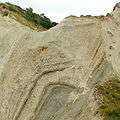MoClay
The Moclay (Moclay = from Danish: moler) strata are formally designated as the Fur Formation.[1] It is a diatomitic sediment of Lower Eocene Epoch, c. 56-54,5 Ma) age which crops out in the Limfjord region of Denmark from Silstrup via Mors and Fur to Ertebølle, and can be seen in many cliffs and quarries in the area. The Diatomite Cliffs (Moler) is on the Danish list of tentative candidates for World Heritage and may become a world Heritage site. The Heritage Agency of Denmark
 Image showing the distinct geological layers.
Image showing the distinct geological layers. An inland location.
An inland location. Unidentified Scorpionfly (Mecoptera) from the Fur Formation
Unidentified Scorpionfly (Mecoptera) from the Fur Formation These cliffs of Fur have been a rich source of fossils.
These cliffs of Fur have been a rich source of fossils.
It is known for its abundant fossil fish, insects, reptiles, birds and plants. The Fur Formation was deposited just above the Palaeocene-Eocene boundary, about 54-55 million years ago, and its tropical or sub-tropical flora indicate that the climate after the Paleocene-Eocene Thermal Maximum was moderately warm (approximately 4-8 degrees warmer than today).
The Fur Formation is divided into two members: The lower Knudeklint Member was named for a location on the island of Fur. The upper Silstrup Member was named for a location on Thy.
Glacial tectonics have moved and folded all exposed mo-clay in a complicated pattern which permits very precise mapping of movements of glaciers in the late part of the last ice age app. 25,000 years ago, and has due to the ashlayers created an extraordinary pedagogical case for studying tectonics.
References
| Wikimedia Commons has media related to MoClay. |
- Pedersen, G.K. & Surlyk, F. 1983: The Fur Formation, a late Paleocene ash-bearing diatomite from northern Denmark. Bulletin Geological Society of Denmark, 32, 43-65.